
 |
| Home - Law Land - Percy Land - Blanck - Petermann | ||
|
Hoboken
Much has been written about Colonel John Stevens and the Stevens family in Hoboken. Stevens put Hoboken on the map by offering ferry service from New York to Hoboken where city dwellers could enjoy the fresh air of suburban New Jersey. In the late 1850s the North German Lloyd and Hamburg American steamship lines moved from Manhattan to Hoboken. The North German Lloyd sailed between "New York", Southampton and Bremen, Germany. The Hamburg America sailed between "New York", Southhampton and Hamburg. Over time other lines arrived in Hoboken, extending the waterfront. The two German steamship companies attracted a large German population. Adding to the city's growth was the arrival of the railroads starting in 1862. Hoboken became a major rail terminal for commerce between New York (and New England) and the mid west. Hoboken was incorporated in 1855. City Hall was completed in 1881. In 1891 a million dollars worth of new buildings were constructed. Hoboken was in its heyday between 1880 and 1910. It had a combination of affordable housing for workers and elegant housing for the well-to-do who liked the views of the New York skyline.
"pop in 1850, 2,668; in 1860 9,662; in 1870, 20,297 of whom 10,334 were foreigners"Hoboken had Irish, Italian and German enclaves. But it was perhaps the German culture that dominated until World War I. Hoboken was a center of German culture, with German Churches, beer halls, news papers, social clubs etc. The large numbers of German immigrants living in Hoboken earned it the nickname of "Little Bremen". Blanck, Erxmeyer, Kettler, Land and Petermann in Hoboken My ancestors, the Petermanns and Lands, lived in Hoboken. The Petermanns were in Hoboken from circa 1885 to about 1910. The Lands were in Hoboken from circa 1895 to 1897. Law Land and his son, Percy, returned for a short period of time in 1906/07. I believe they were working on the construction of the train station in 06/07. My husband, Tom's ancestors, the Blancks, Erxmeyers and Kettlers also lived in Hoboken. The Blancks and Erxmeyers arrived in the mid 1870s. Some Blanck and Erxmeyer family members were still there until the 1940s. The Kettlers arrived in the early 1890s. Some family members were still there in 1930.
At one point in 1886/87 the Blancks and the Petermanns lived on the same block of Willow Street. Since both families had young boys of the same age it is highly likely that they had at least a nodding acquaintance. See Did Our Ancestors Know Each Other |
|
|
| Ferry Terminal and Train Station
For many years no trains went directly into New York City. Trains coming from the south and west terminated in Jersey City or Hoboken. Passengers then transfered to ferries to make the final leg to the city.
| |
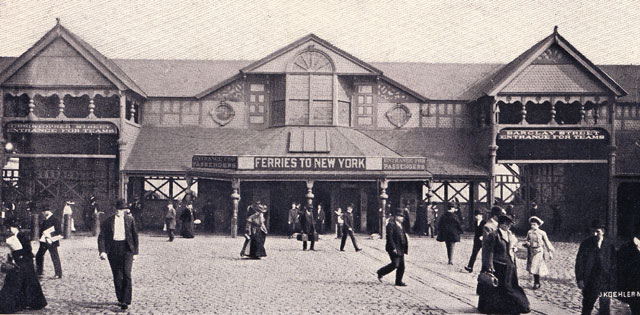 | |
| Postcard collection of Maggie Land Blanck Old Hoboken Ferry Terminal, Hoboken N. J., Pre 1905 Christopher and Barclay Street Ferries Hoboken, N. J. Ferries to New York. Entrance on the left says: "Christopher Street Entrance for Teams". That on the right is the Barclay Street Entrance for teams and the central entrance is for passengers. Not posted | |
| To see more images of the ferry terminal and train station click on the picture of the fire boat |
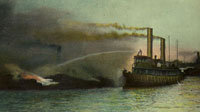
|
|
| |
|
The Hudson River Tunnels The first attempt to build a tunnel under the Hudson was started in 1874 and was abandoned in 1892 for financial reasons. In 1902 construction was restarted by the New York and New Jersey Railroads. Two tunnels were completed running side by side The underwater railroad tunnel open February 25, 1908. The new "subway" line ran from Hoboken, New Jersey to 19th street and 6th Ave in Manhattan. By 1910 it had been extended to its present terminus at 33rd Street. The tunnel to the brand new Hudson Terminal building on Church Street in Lower Manhattan opened in 1909. Other tunnels followed. They later became part of the PATH system. Bud Land said that his mother, Meta Peterman, and her sister, Annie, walked from Hoboken to New York in a tunnel before it opened to the public for use. They most likely walked through what is now the PATH tunnel.
| |
 | |
| Postcard collection of Maggie Land Blanck Hudson Tunnels, Mezzanine Floor, Hoboken Terminal | |
|
| |
| To see more images of the Hudson tunnels
click on the picture of the tunnel
|
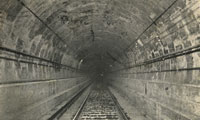
|
|
| |
| Public Buildings, Hoboken, N.J. | |
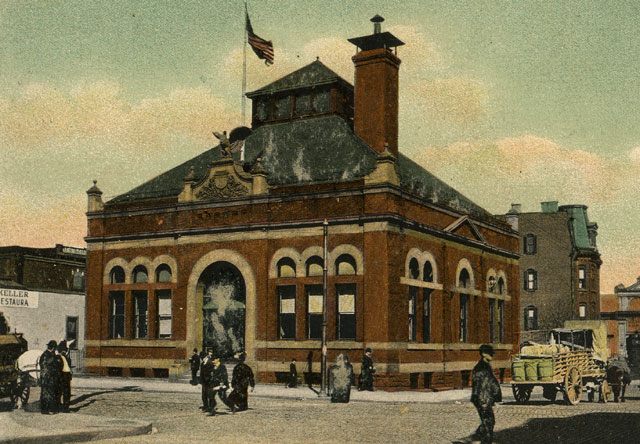 | |
| Postcard collection of Maggie Land Blanck Post Office. Not posted | |
| To see more images of the other public buildings in Hoboken click on the picture of the post office |
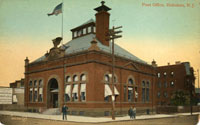
|
|
| |
| The Piers Hoboken was the New York City port for several steamship lines including the North German Lloyd, the Hamburg-American, the Netherland-American and Scandinavian.
| |
 | |
| Postcard collection of Maggie Land Blanck | |
|
Hamburg-American Line Piers, Hoboken
Posted 1910
| |
| To see more images of the piers in Hoboken click on the picture of the ship docking |
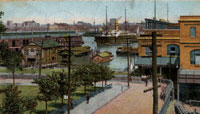
|
|
| |
|
The Parks
| |
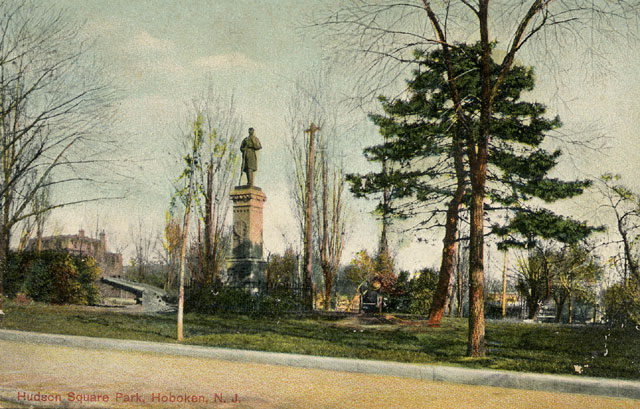 | |
| Postcard collection of Maggie Land Blanck | |
| Hudson Square Park Post marked 1908
| |
| To see more images of the parks in Hoboken click on the picture of the Hudson Square Park |
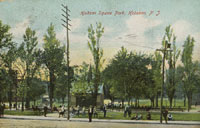
|
|
| |
|
The Churches
| |
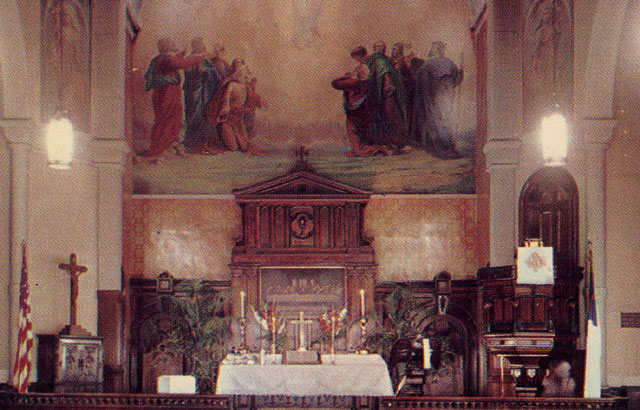 | |
| Postcard collection of Maggie Land Blanck | |
| St Matthew's Ev Lutheran Church 8th and Hudson Streets, Hoboken
| |
| To see more images of the churches in
Hoboken click on the
picture of the the door of St Paul's Church
|

|
|
| |
|
From Hoboken to the Heights Hoboken fronts on the Hudson River accross from Manhattan. The Palisades, a line of steep cliffs which rise nearly vertically, seperate Hoboken from Jersey City and Union City (part of Union City was once called West Hoboken). Various cuts, tunnels, trestles, elevators, staircases, roads and inclines bridged the elevation. Many of them like the Ferry Street Trestle Hoboken, the Inclined Cable Railway and Hoboken Wagon Elevation are now gone.
| |
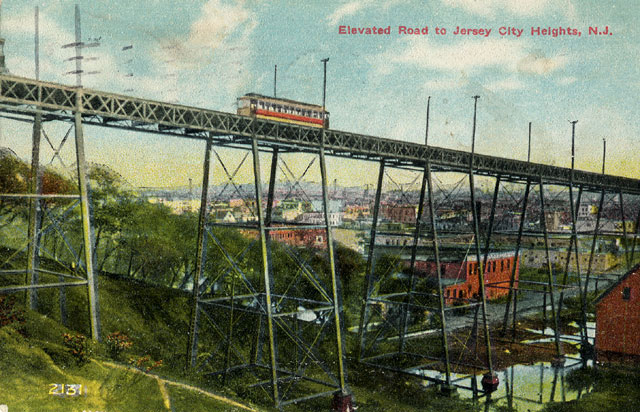 | |
| Postcard collection of Maggie Land Blanck | |
|
Post marked 1911 The Ferry Street railroad trestle was completed in 1886 and was a great improvement over the incline that hauled traffic up the palisades to Jersey City Heights. However the inclined remained in use for moving cargo for some period after the trestle was built. | |
| To see more images of the means to the Heights
click on the picture of the Elevated Railway
|
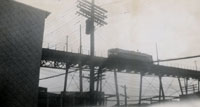
|
|
| |
|
Stevens Institute
| |
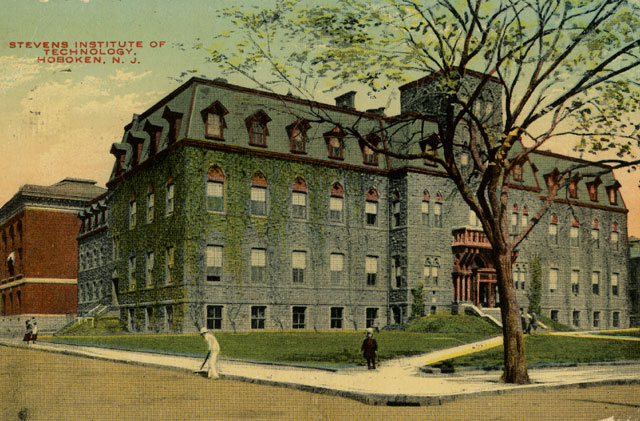 | |
| Postcard collection of Maggie Land Blanck | |
|
Stevens Institute of Technology, Hoboken
| |
| To see more images of the Stevens Institute
in
Hoboken click on the
picture of Castle Point
|
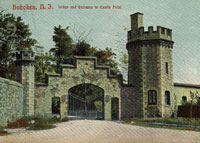
|
|
| |
| The Streets of Hoboken
The streets from south to north are: Ferry, Newark, followed by 1st through 18th Streets. House numbers start in the 30s west of River Street. I believe that River Street was also called Fifth Avenue. See M Loewy postcards dated 1904 and 1905. The streets from east to west are: River, Hudson, Washington, Bloomfield, Garden, Park, Willow, Clinton, Grand, Adams, Jefferson, Madison, Monroe, Jackson, Harrison and Marshall. The Petermann Family lived for many years at 36 2nd Street (just west of River Street). The Lands lived at 213 14th street in 1897 (between Garden and Park). Fred Erxmeyer lived at 157 3rd Street in 1899 (between Bloomfield and Garden). Gertrude Kettler was at 253 3rd Street in 1907 (between Park and Willow). House numbers correspond to the cross street:
Known addresses for all of the connected families were no further west than Adams Street. The Blancks were living as far north as 11th Street by the 1940s. The Lands were at 14th Street in the 1890s. At that point 14th Street must have been fairly undeveloped compared with the rest of the town. Most of the other known addresses were concentrated between Ferry and 5th and River and Willow.
| |
|
Hudson Street
| |
 | |
| Postcard collection of Maggie Land Blanck | |
| Hudson Street looking North, Hoboken, N.J. Stephen's buildings on the right and the spire of St Matthew's in the distance. | |
| To see more images of the Hudson Street
click on the
picture of Hudson Street
|

|
|
| |
|
Newark Street
| |
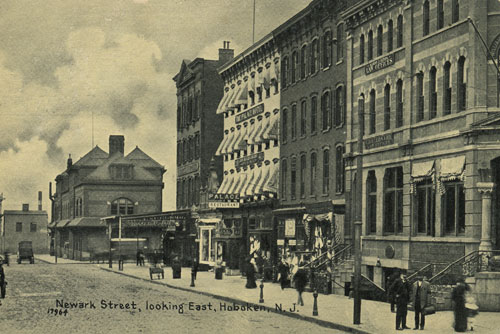 |
Newark looking east,
Hoboken, N. J.
Posted 1908
|
| Postcard collection of Maggie Land Blanck | |
| To see more images of the Newark Street
click on the
picture of Newark Street.
|
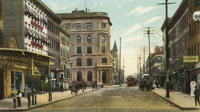
|
|
| |
|
Washington Street
| |
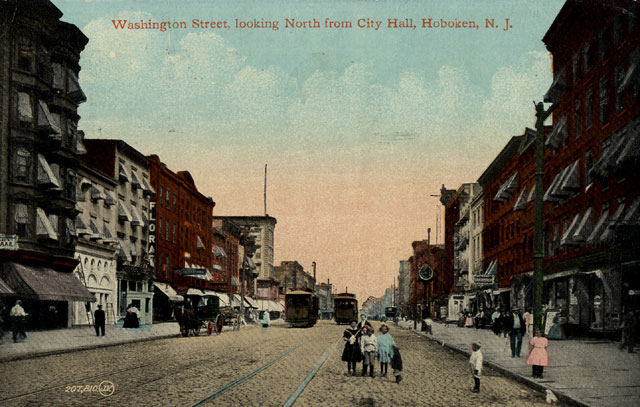 | |
| Postcard collection of Maggie Land Blanck
Washington Street looking North from City Hall, Hoboken, N.J.
Posted 1913 Washington was and is the main commercial street in Hoboken. On the left side of the street can been seen a sign for "Flora". While the name was listed in the 1910 census in Hoboken I could not find a family in business on Washington Street.
According The History of Theatre, Vaudeville and Movies in Hoboken. Volume 1., Booklet by Jim Hans, Compiled and Published by the Hoboken Historical Museum, Hoboken, [1987] the Flora German Variety Concert Hall was located at 118 Washington Street between 1907 and 1913 and the Orpheum was located at 127 Washington Street between 1908 and 1913. (Bill Craig, March 2008)The sign just beyond Flora is "Dental Parlor" followed by "Cigars". On the right side of the street the clock in the distance says a quarter to eleven. A little in front of that is a vertical sign "Orpheum". Further forward is a horizontal sign "Braunstein". The 1910 census which is VERY hard to read lists "Leonard" (?) Braunstein age 39, born Romania, dealer in (can't read) commercial store, his wife, Henrietta, age 25, and sons Roy (or Ray) age 6 and Walter age 4. They are listed in Ward 1. However, I cannot read the street address. The Braunstein family, "Ben" age 48 shopkeeper jewelry, Henrietta, age 34, Ray age 17 and Walter age 13 were in New Providence New Jersey in 1920. Circa 1913 B Braunstein had a large jewelry store on the corner of 3rd and Washington Streets
| |
| To see more images of the Washington Street
click on the
picture of Washington Street.
|

|
|
| |
|
River Street
| |
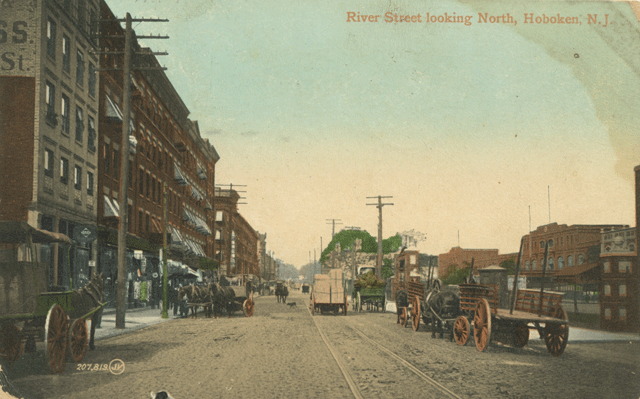 | |
| Postcard collection of Maggie Land Blanck | |
| |
| To see more images of the River Street
click on the
picture of River Street.
|
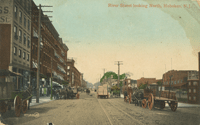
|
|
| |
|
Other Streets
| |
 | |
| Postcard collection of Maggie Land Blanck
11th Street Looking West, Hoboken, N.J.
| |
| To see more images of other streets in
Hoboken
click on the
picture of 11th Street.
|
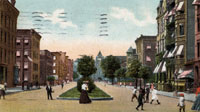
|
|
| |
|
Bird's Eye View
| |
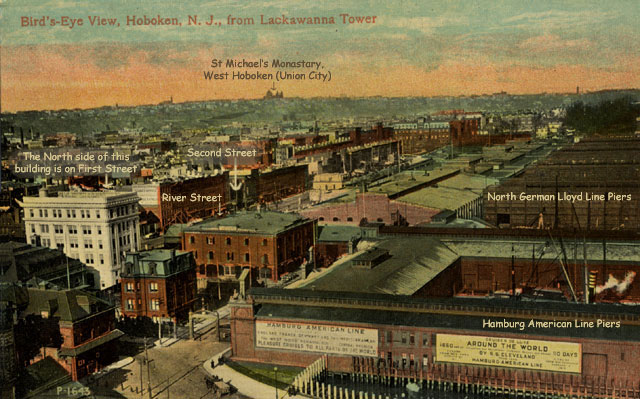 | |
| Postcard collection of Maggie Land Blanck Hoboken as seen from the clock tower of the Train Terminal. Signs on side of building read Hamburg American Line | |
|
Reception of the Royal Saxon Military Band, 1873
| |
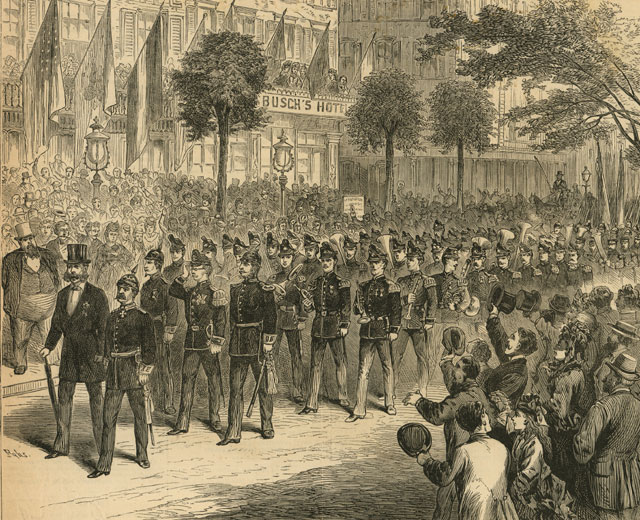 | |
| Print collection of Maggie Land Blanck Hoboken, N. J. - Reception of the Royal Saxon Military Band by the Landwehrverein and Committe Frank Leslie's Illustrated Newspaper June 12, 1873 The 1880 Census shows Herman Busch age 50, hotel keeper, born Hanover, his wife Caroline age 34, Augusta daughter age 13, Caroline daughter age 9, Herman D son age 7, and a servant at 115 Hudson Street. | |
|
Keuffel and Esser
| |
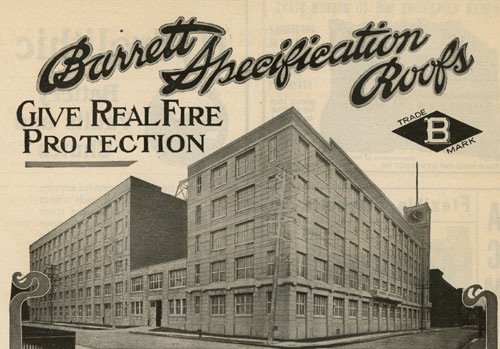 | |
| Print collection of Maggie Land Blanck Of the noted early firms in Hoboken was Keuffel and Esser a manufacturer of surveying instruments. They were established in 1866 at Adams and Third Streets. This image of the Keuffel and Esser Plant is from an advertisement for Barrett Fireproof Roofs printed in The Railway Age Vol. XLV No. 4 January 24, 1908 The company originally imported precision engineering instruments. Subsequently they opened a factory in Hoboken. They were the first producers of the slide rules in the United States. John Blanck worked for K & E from the time he was a teenager until he was in his late 50s. K & E raised spiders in their basement to obtain filament for cross hairs in gun sites. The K & E plant was destroyed by fire in 1906. The K & E operations moved to Morristown in the 1960s. | |
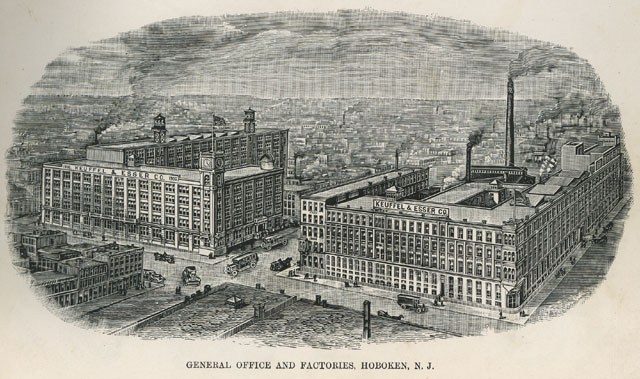 | |
| Print collection of Maggie Land Blanck From the Keuffel and Esser 1944 Catalog 40th edition. | |
|
Bavarian Yodelers Meyer's Cellar
| |
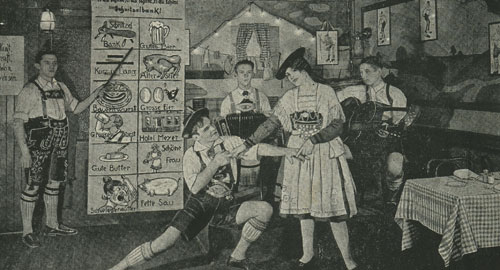 |
Bavarian Yodelers, Meyers Cellar,
Hoboken, N. J.
Posted 1935 Meyer's Hotel Wiener Schnitzil, Pigs Knuckles, Bauernwurst, Sauerbraten mit sauerkraut |
| Postcard collection of Maggie Land Blanck | |
|
WW I Parade Float
| |
 |
WWI Parade float Printed on back "Photo of World War One Hoboken parade float, River Street near Fifth. Donated by Lois Kruse Mohns. Her cousin, George Crawford, is shown standing far left. Photo circa 1917, R. Magnus, Hoboken, New Jersey. |
| Published 1991 by the Hoboken Historical Museum. Postcard collection of Maggie Land Blanck | |
|
Hoboken ??
| |
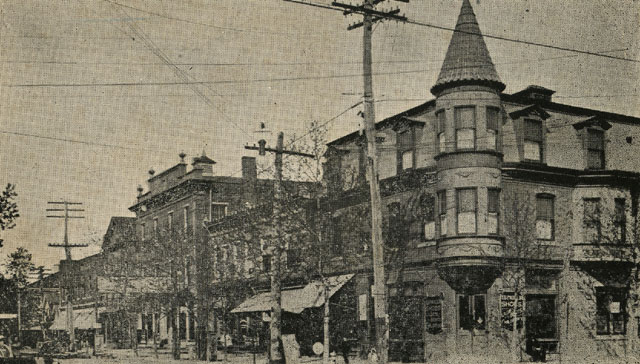 | |
| Postcard collection of Maggie Land Blanck
This card was billed as "Bellvue Ave, Hoboken" when I bought it online. However, there is nothing printed on the card. The notation "Bellvue Ave, Hoboken N. J. - Main Street" is lightly written in pencil on the back of the card. In December 2016 David Avery sent a copy of an 1853 map showing Bellvue west of Union Hill and North Hoboken.
| |
|
Continental Hotel, Hudson Street 1943
| |
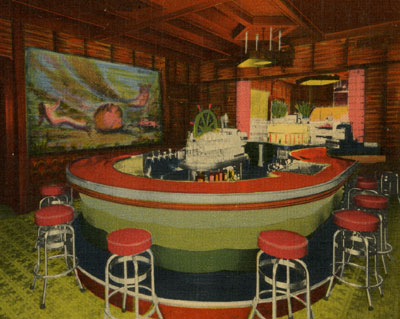 | |
| Postcard collection of Maggie Land Blanck
Meet me at the Continental Bar- It's Air Conditioned - Continental Hotel 101 Hudson Street, Hoboken, N. J. Posted 1943. | |
|
Young women of the Hoboken Academy, 1900
| |
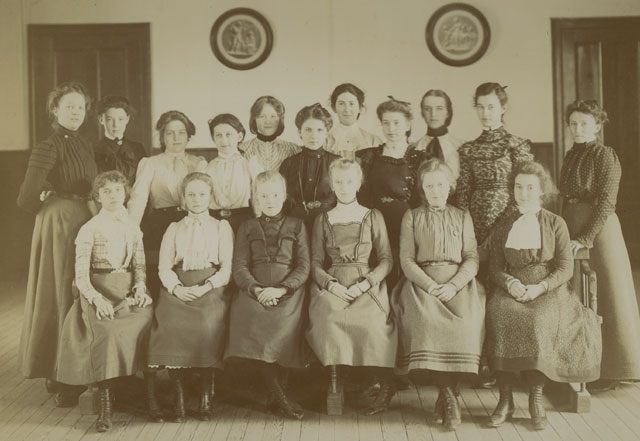 | |
| Photo collection of Maggie Land Blanck "II Academic, May 18, 1900, Hoboken Academy" handwritten on front. "Emma Ruhl - II Academic May 18, 1900" hand written on back "E. F. WALTER 410 Washington Street Hoboken" stamped on back. Hoboken Academy
The Hoboken Academy was at Willow and Fifth. | |
|
HCCC
| |
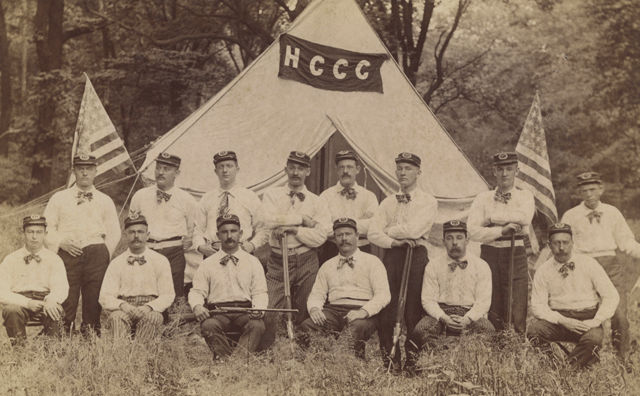 | |
| Photo collection of Maggie Land Blanck I bought this image on ebay and the seller said it came from an album that included images of Hoboken. The flags have 5 rows of stars which puts the date of the picture before 1890. After 1890 flags had six rows of stars. The stars are lined up one under the other - this could suggest the flag that was in use between 1877 and 1890. The insignias on the hats are "HCCC". The type of hat and rifles suggest Civil War Vets????
| |
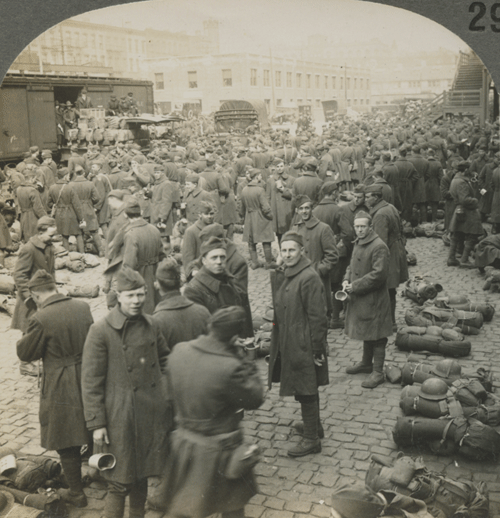 | |
| Photo collection of Maggie Land Blanck Americans Glad to Be Home - Awaiting Trains for Demobilization Camp, Hoboken. World War I started in 1914 as an armed conflict between France, Russian and the United Kingdom on the one side and German, Hungary, Turkey (Ottoman Empire) and Bulgaria on the other.The US tried to remain neutral but eventually entered the war in April 1917. Almost 2 million soldiers were shipped out through Hoboken. Hoping for a speedy end to WWI General Pershing told the troops they would be in "Heaven, Hell or Hoboken" by Christmas 1917. The war did not end until November 1918. After the US entered the war there were significant issues for many German Americans. Many were looked upon with suspicion. German names of cities, streets, food, organization, businesses, theaters, etc. were changed. (Frankfurters became hot dogs.) German America schools were forced to close. German was not allowed to be preached from the pulpit. German language newspapers were banned. German language books were burned by libraries. Many German Americans Americanized their names and ceased speaking German, even at home. The federal government seized the German piers and shipping lines in Hoboken, closed most of the beer gardens and detained hundreds of Americans of German descent. | |
|
Hoboken 1881
| |
 | |
| 1881 View of Hoboken
Key to the numbers added to map:
| |
|
Bird's Eye view of Jersey City, Hoboken and the
New York Harbor
| |
| Hoboken, N J, Jersey City, N J,
Red Hook, Brooklyn and the New York Harbor
| |
 | |
| Map collection of Maggie Land Blanck | |
| The 1900 Hoboken Pier Fire The Hoboken Piers of the North German Lloyd Steamship Company burned in a huge fire on June 30, 1900. After the fire the company temporarily used piers in Brooklyn. By November 1900 they had decided to rebuild new steel piers in Hoboken. By April 1901 enough of the piers were in place for the North German Lloyd steamship, Grosser Kurfuerst, to dock in Hoboken. This was the first steamship to dock in Hoboken since the fire. The arrival of Grosser Kurfuerst was greeted with great fanfare.
| |
 | |
| Postcard collection of Maggie Land Blanck | |
| Steamships Burned Seale, Bremen, Main, and Kaiser Wihlem de Grosse (later damaged) Piers of the North German Lloyd in Hoboken in Flames For more information and photos of the 1900 Pier Fire click HERE
| |
| German Hoboken
| |
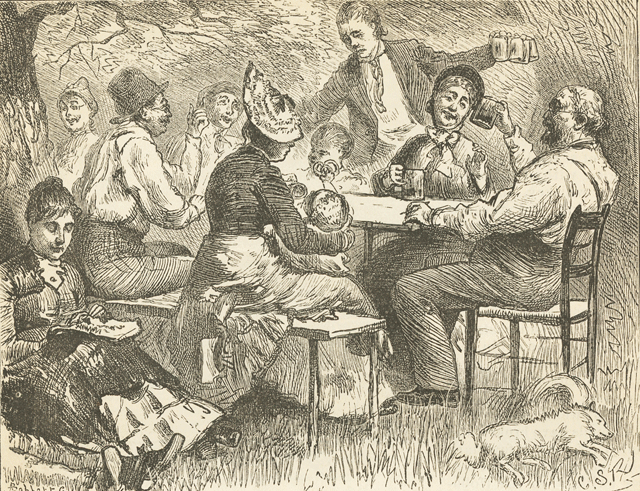 | |
| Collection of Maggie Land Blanck A GERMAN BEER GARDEN, HOBOKEN Harpers, October 1878 | |
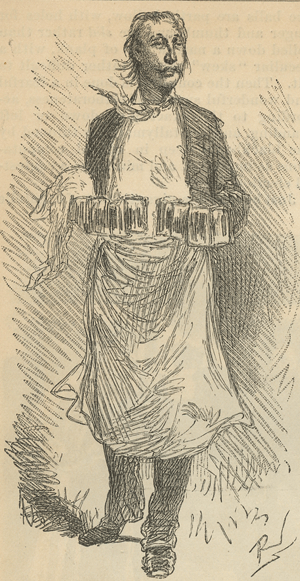 | |
| Collection of Maggie Land Blanck HOBOKEN LARGER Harpers, October 1878 | |
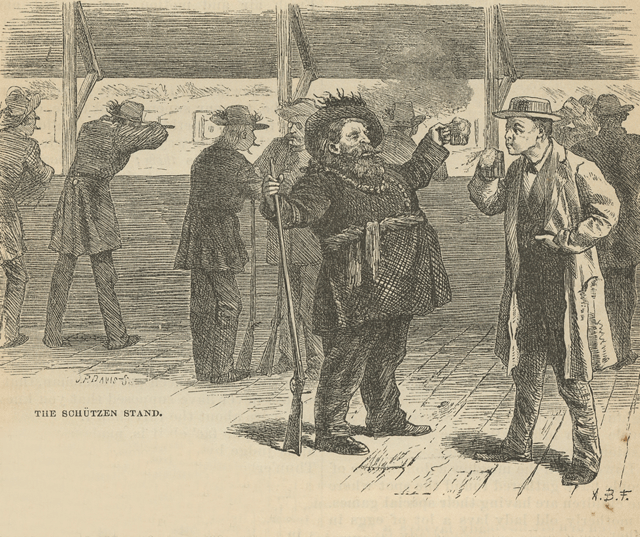 | |
| Collection of Maggie Land Blanck THE SCHUTZEN STAND Harpers, October 1878
| |
|
The article from which these images were taken described
the Schützen Park Canstätter Volksfest as a popular "Suabian" harvest festival. The writer took the Christopher Street Ferry from Manhattan to the Jersey side and then took the incline to the top of "Hoboken Heights" from there he went by horse-railway north and was "transferred from America and Yankee surroundings, to something much like an outlying suburb of Berlin or Bermen." "The first look of the place inside the gates suggests only an ordinary suburban beer garden — a pine-clad hillock, a few sheds with rude placards in Suabian German of inviting eatables and drinkables, and the chronic beer counter. But a few steps through the trees down the steep western slope brings us out into the clear, and we begin to see how pretty it all is. Right at our feet is a pretty little music temple, with a tolerable band playing lively airs, to the delight of the promenaders scattered along the broad, neatly kept gravel walk which runs nearly the length of the park, edged with flower beds and rustic seats, running off northward into rural plantations, and terminating at the southern end at the clubhouse of the Schultzen Verein, or Rifle Association — a solid, handsome building in dark stone, of castellated architecture and densely draped in ivy. Opposite the music temple, across the promenade, lies a group of buildings — a large restaurant, with bowling alley in the basement, and a great covered floor for dancing, crowded with the most motley assemblage of hilarious Teutons."Some of the younger girls and almost all of the little ones were dressed in typical German peasant costume "velvet or stuff bodice, chemisette, braided hair, queer black hoods, short colored skirts, and white stockings." Some men were dressed in "knee britches and wrinkled boots, long-shirted blue coats with bright buttons, and cocked hats". In the morning there had been processions, speeches, singing and "other social doings". In the meadow there was organ grinding, singing, ten-pin balls, and rifle shooting. In the center of the meadow stood some sort of tower made of fruits and vegetables: "The base was banked with pumpkins and squashes and cabbages and melons and other ponderous and high-colored vegetables, artistically fitted in with a due regard to contrast of color, trimmed and mortised with layers of evergreen and great cool leaves, while at the fur corners stand great bouquets of natural flowers and grapes. The slender shaft is carried up with a variegated brilliant masonry of cucumbers, and tomatoes and apples and pears and peaches and similar ornamental fruit crowned by an imitation bronze statue of allegorical import."The meadow was lined with flag decorated booths selling beer, wine, wurstel sour-krout, potato pancakes, and other German delicacies. There were games for children and adults. | |
|
The Schuetzen Park, was located in North Bergen. People came from all
the German communities in the New York metropolitan area - Jersey City, Hoboken, Brooklyn,
New York City.
It still exists in an altered form at
Kennedy Blvd and the Hackensack Plank Road.
There were Schuetzen Parks or "shooting park" all across the United States wherever there was a sizable German-American population. Baltimore, Md., Davenport, Iowa, Philadelphia and Pittsburgh had Schuetzen parks. The parks contained target ranges for rifle marksmen. In addition many Schuetzen parks had places to eat, drink, dance and bowl. Favorite foods were wurst, sauerkraut, kummerl, Schweitzerkase, kuchen. Lager beer was the most popular drink. The property for Schuetzen Park in North Bergen was purchased by the Plattduetsche Volksfest Verein club in 1894. Clubs like the Plattduetsche Volksfest Verein were originally organized as insurance clubs where people paid a bit each week and then when someone got sick or died the club would assist the family. Such clubs were popular in many ethnic groups. 
Corner of 1st and Washington (NW corner) circa 1871 old number 52 (new number 100) - Turn Verein - Rutgers University Library online
The Hoboken Turn Verein was one of the oldest gymnastic and athletic societies in New Jersey. 1891: "The Hoboken Turn Verein held a successful fair at their spacious hall during the past twelve days. In the shooting for a handsome gold medal, the winner being J. H. Kruse. of the Miller Rifle Club, with a clean score, 25 26 25 75. A few minutes before the shoot ended L. Schmidt, a member of the G. S. P. protested against the winner receiving the prize, as the score bad been made with his own rifle. Mr Kruse claimed that he had let his rifle to the Verein, and, therefore, he could shoot as much as he pleased. Mr. Kruse was, however, not presented with the medal. Schmidt was again beaten out for the evening's prize, a barrel of apples, leading up to 7 P. M. with 74. Kruse going him one better, making another clean score 25 25 25 75. The matter will be decided at the meeting which takes place to-night, Dec. 9, 1891." Forest and Stream, Volumes 36-37 | |
|
The Blancks, Erxmeyers, Kettlers, Lands, and Petermanns in Hoboken
| |
|
Several branches of the Land/Blancks lived in Hoboken. Tom Blanck was born in Hoboken where his father's ancestors, the Blancks, Erxmeyers, and Kettlers had settled. Meta Petermann, was born in Hoboken where she met her husband, Percy Land, whose family had lived for a while in Hoboken. The Erxmeyers arrived in Hoboken in the late 1860s or early 1870s. Henry Blanck arrived in Hoboken circa 1870. Fritz Kettler immigrated from Germany circa 1883. After a brief stop in Brooklyn the Kettler family moved to Hoboken circa 1890. The Petermann family also immigrated from Germany circa 1883. They also stopped first in Brooklyn, moving to Hoboken circa 1885. The Land family, who were originally from England, moved to Hoboken, via Detroit, Michigan and Toronto, Canada, in the mid 1890s. |
|
The Steamship Companies and
Railroads in Hoboken
| |
|
Much of Hoboken's economy was tied to the waterfront. The Steamship Lines In the late 19th century Hoboken became the New York port for several steamship companies and had one of the most thriving wharfs in the New York Harbor. Two German steamship companies, the Hamburg-American (Hamburg Amerikanische Packetfahrt Actien Gessellschaft, or HAPAG founded in 1847) and the North German Lloyd (Norddutscher Lloyd, or NGL founded in 1858), were established in Hoboken in 1863. The Hamburg-American line with 55 ships had their piers at the foot of 1st Street and was known for its service between New York and Hamburg, Germany. The North German Lloyd line with 14 ships had their piers at the foot of 3rd Street and was known for its tri-weekly service between New York and Bremen, Germany. These lines brought large numbers of Germans immigrants into Hoboken and by the 1890s about a quarter of Hoboken's population was German. The Netherlands-American Line (later the Holland American line) was established in 1872 with a pier at the foot of 5th Street and service was between Rotterdam and New York. The Thingvalla Steamship Company (later the Scandinavian Line) was organized in 1879 running service between Copenhagen and New York. Their dock was at the foot of 4th Street. By 1880 the Wilson Line, running service to England and consisting of eight steamers, was between Second and Third Streets. A 1906 map of Hoboken shows the Tietjen and Lang Dry-Docks between 16 and 18th Streets. Importing and exporting made Hoboken an important warehousing and wholesaling center. In the early years, the cargo to Europe was livestock and the cargo to America was people. Larger ship held form 1,500 to 2,000 passengers. An average steerage ticket cost $30.00. The largest ships could make $60,000 on a single voyage. The Trains Hoboken was also the terminal for the Delaware, Lackawanna and Western Railroads and the Hoboken Shore Railroad. It was an important point of embarkation for arriving immigrants and much of Hoboken's economy was tied to the steamship companies and the waterfront. The Lackawanna Train and Ferry terminal was at the southernmost end of the city with the steamship company piers stretching to the north. The northern end of the city was not as well developed as the southern end. The area to the east and closer to the water was developed before the western part of the city. The Blancks, Erxmeyers, Kettlers and Petermanns all initially lived in the southeastern section. The Lands lived in the northeastern section. However, when Law and Percy returned to Hoboken to work after 1900 they stayed in the southeastern part of town. The southern part of the water front from Ferry Street to 4th Street was pretty much taken up with piers and the train/ferry terminal so the local residences did not get to see the water unless they took a ferry or worked on the docks. There was a restaurant in the train station with windows facing the water and summer eating outside on an awning covered balcony. It was one of the few spots where one could see the water and it was a popular eating place until it closed during WWII.
|
|
Population and Growth of Hoboken
| |
|
Hoboken underwent a great period of growth between 1880 and 1920 that corresponds
to the general period of urban growth in the United States.
The number of manufacturing industries in Hoboken increased from 121 in 1879 to 399 in 1899. Most of the concerns were small, with most firms employing less than 20 people. 1850's By the mid 1800s there were 7,000 people in Hoboken. More than 1,500 of there were German. 1905 Census According to the Supervisor's Report for the 1905 New Jersey Census: Hoboken had 65,468 inhabitants. 40,716 were born in American, 835 were born in England, 3,574 were born in Ireland, 10,322 were born in Germany, 4,964 were born in Italy and 5,057 were born in other countries. Number of dwellings 4,227. Number of families 14,656. 1915 Census The population of Hoboken in 1915 was 67,611. There were 15,322 families living in 4,511 dwellings. 41,610 were American born. The Germans was the highest foreign born group with 8,062 followed by the Italians with 7,328. As expected in a town where the docks were a major source of income, males outnumbered females: 35,102 males and 32,509 females. |
| If you have any suggestions, corrections, information, copies of documents, or photos that you would like to share with this page, please contact me at maggie@maggieblanck.com |
| Meta Petermann's Hoboken Friends |
| Current photos of places the Blancks lived in Hoboken |
| New York City and Brooklyn also had German enclaves. See New York City Images |
| Germans in America |
| Professor M. Loewy - Magician, postcard and stamp collector |
| Hoboken Photographers |
For information and images of the old buildings and signs as seen today
go to
Forgotten Street Scenes
|
For more old Hoboken images
go to
New Jersey Digital Highway
| |
|
Please feel free to link to this web page.
|
| ©Maggie Land Blanck - Page created 2004 - Latest update, June 2020 |